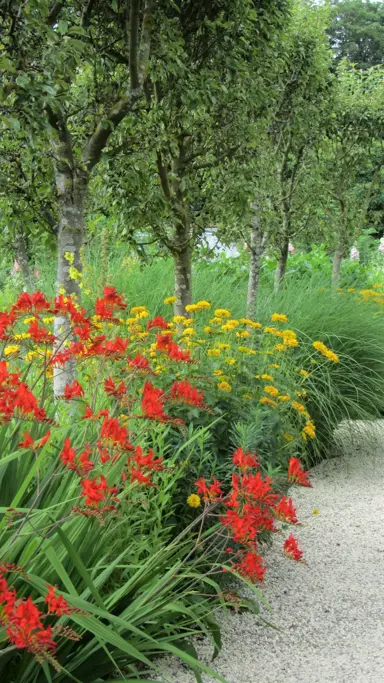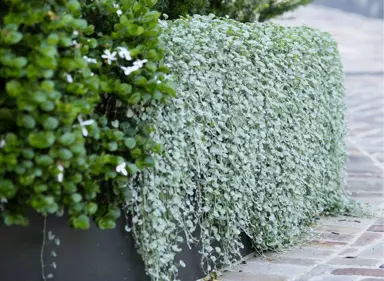
Viburnum plants are versatile shrubs prized for their attractive foliage, flowers, and berries. Available in both evergreen and deciduous varieties, they add year-round interest and structure to New Zealand gardens. Whether for hedging, screening, or specimen planting, our nursery-grown Viburnum plants thrive in a range of conditions. Purchase healthy Viburnum plants with fast nationwide delivery from The Plant Company.
Viburnum Bewleys Variegated is an evergreen shrub that features variegated foliage and showy flowers. Pink flower buds open to reveal showy clusters...
Viburnum burkwoodii is an evergreen shrub that features lovely foliage and showy flowers. Pink flower buds open to reveal showy clusters of fragrant...
Viburnum davidii is a popular evergreen shrub that features lovely foliage and showy flowers. Pink flower buds open to reveal showy clusters of white...
This female variety of Viburnum is a popular evergreen shrub due to its lovely foliage and showy flowers. Pink flower buds open to reveal showy...
Viburnum Dense Fence is an evergreen shrub that features glossy foliage that emerges red and ages to become dark green. Left untrimmed it will grow...
Viburnum Emerald Beauty is a popular variety due to its impressive foliage and showy flowers. Purple-pink flower buds open to reveal showy clusters...
Viburnum 'Eve Price' is a compact, evergreen shrub admired for its flowers, foliage, and tidy form. It features dark green foliage, pink buds in...
Viburnum opulus 'Sterile' is a deciduous shrub known for its beautiful clusters of white flowers without producing berries. This low-maintenance...
Viburnum tinus variegatum is an evergreen shrub that features variegated foliage and showy flowers. Pink flower buds open to reveal showy clusters of...
“Anvi” is a variety of Viburnum and is an evergreen shrub grown for its foliage and flowers. Showy clusters of white, pompom-like flowers appear...
“Dawn” is a deciduous and popular variety of Viburnum due to its foliage and flowers. Pink buds open to reveal showy clusters of small and fragrant...
Viburnum carlesii, commonly known as the Korean Spice Viburnum, is a deciduous shrub grown for its lovely foliage and showy, fragrant flowers. Pink...
This male variety of Viburnum is a popular evergreen shrub due to its lovely foliage and showy flowers. Pink flower buds open to reveal showy...
Viburnum Emerald Lustre features pink flower buds that open to reveal clusters of mildly fragrant, white-light pink flowers during winter and early...
Viburnum Eskimo features impressive foliage and showy flowers. The cream-white flowers appear like giant snow balls and literally coat the plant...
Viburnum Hedge Master is an evergreen shrub grown for its lush and colourful foliage. The glossy foliage emerges red and ages to become dark green...
Viburnum japonicum features impressive foliage and showy flowers. Pink flower buds open to reveal showy clusters of mildly fragrant, white flowers...
Viburnum tinus Lucidum is an evergreen shrub grown for its foliage and flowers. Pink buds open to reveal showy clusters of white flowers during late...
Viburnum plicatum Newport is a variety of the commonly known, Doublefile Viburnum, and is a deciduous shrub grown for its foliage and flowers. Showy...
Viburnum odoratissimum, commonly known as Sweet Viburnum, features impressive foliage and showy flowers. White buds open to reveal showy clusters of...
Viburnum "Awabuki" is a popular evergreen shrub that features lovely foliage and showy flowers. Showy clusters of white flowers are borne amidst the...
Viburnum opulus is a deciduous shrub prized for its clusters of fragrant white flowers in spring and striking red berries in autumn. This versatile...
Viburnum opulus 'Notcutts Variety' is a deciduous shrub valued for its large, fragrant white flower clusters in spring and vibrant red berries in...
Viburnum opulus 'Roseum', commonly known as the Snowball Tree, is a deciduous shrub celebrated for its striking, globe-like clusters of pure white...
Viburnum plicatum, commonly known as the Japanese Snowball Plant, is a deciduous shrub that features showy clusters of white, pompom-like flowers...
Viburnum plicatum Grandiflorum is a variety of the commonly, Japanese Snowball Plant, and is a deciduous shrub grown for its foliage and flowers...
Viburnum plicatum 'Lanarth' is a beautiful deciduous shrub known for its tiered branching and masses of pure white lacecap flowers in spring. Perfect...
Viburnum plicatum Mariesii is a variety of the commonly known, Japanese Snowball Bush, and is a deciduous shrub grown for its layered foliage and...
“Roseum” is a deciduous variety of Viburnum and is grown for its foliage and stunning flowers. Showy clusters of pompom-like flowers are borne during...
Viburnum “Summer Snowflake” is a popular variety that features impressive form, foliage and flowers. Light pink flower buds open to reveal showy...
Viburnum plicatum "Tomentosum" is a variety of the commonly known, Japanese Snowball Bush, and is a deciduous shrub grown for its layered foliage and...
Viburnum setigerum, commonly known as Tea Viburnum, is an evergreen shrub grown for its berries, foliage, and flowers. Showy clusters of small, white...
“Splendens” is a vigorous shrub grown for its dazzling display of flowers. This vigorous plant grows densely with branches holding long, dark green...
Viburnum tinus, commonly known as Laurustinus, is a dense, evergreen shrub ideal for hedging, screening, or mixed borders in New Zealand gardens. It...
Viburnum tinus 'Gwenllian' features impressive foliage and showy flowers. Red flower buds open to reveal showy clusters of mildly fragrant, white...
Commonly known as The American Cranberry Bush, this deciduous variety of Viburnum is grown for its flowers and colourful fruits. Showy clusters of...
Viburnums are valued for their easy care, adaptability, and ornamental appeal. Their fragrant flowers and colourful berries attract pollinators and birds, enhancing garden biodiversity. Suitable for borders, hedges, and mixed shrub beds, Viburnums fit well in both formal and informal NZ garden designs.
Plant Viburnum shrubs in well-drained soil with full sun to partial shade. Water regularly during establishment and mulch to conserve moisture. Prune lightly after flowering to maintain shape and encourage dense growth. Our expert guides help ensure your Viburnum plants thrive in NZ gardens.
We supply premium nursery-grown Viburnum plants selected for New Zealand’s climate. Our healthy, robust stock establishes quickly and comes with expert advice to help your garden flourish. Enjoy fast, reliable nationwide delivery and personalised support.
Whether you need assistance finding the plant you’re looking for or you simply want to know more about who we are and what we do, we invite you to get in touch with us today. A member of The Plant Company team will get back in touch as soon as possible.


